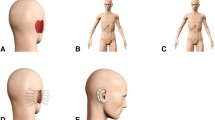Abstract
Background
Total ear reconstruction with porous polyethylene implants leads to three typical skin scars: a scalp scar from harvesting the temporoparietal fascia flap as well as a groin scar and a contralateral postauricular scar from harvesting full-thickness skin grafts. This study evaluates the annoyance of these scars from the patients’ perspective.
Methods
Fifteen patients received structured questionnaires covering the aesthetical outcome and daily impairment by the three scar types, as well as validated questionnaires measuring health-related quality of life.
Results
The ear reconstruction had raised the health-related quality of life in 14 patients. The scalp and groin scars were rated “satisfactory,” and the postauricular scar was “good” on an average. In contrast to the postauricular scar, the annoyance by scalp and groin scars was substantial: Half of the patients had sensation disorders on the scalp or groin. The scalp scar impaired a third of the patients wearing a desired hairstyle and the groin scar a third of the patients wearing swimsuits. A fifth of the patients experienced feelings of shame in the public due to the scalp and groin scars.
Conclusions
While not preventing the beneficial effect of ear reconstruction on patients’ health-related quality of life, scalp and groin scars are annoying for a relevant percentage of the patients. Therefore, the temporoparietal fascia flap should be harvested with the smallest incision possible, full-thickness skin grafts from the groin should be harvested as small as possible, and harvesting areas for full-thickness skin grafts other than the groin should be evaluated.
Level of Evidence: III.


Similar content being viewed by others
References
Braun T, Gratza S, Becker S et al (2010) Auricular reconstruction with porous polyethylene frameworks: outcome and patient benefit in 65 children and adults. Plast Reconstr Surg 126:1201–1212
Horlock N, Vögelin E, Bradbury ET et al (2005) Psychosocial outcome of patients after ear reconstruction: a retrospective study of 62 patients. Ann Plast Surg 54:517–524
Soukup B, Mashhadi SA, Bulstrode NW (2012) Health-related quality-of-life assessment and surgical outcomes for auricular reconstruction using autologous costal cartilage. Plast Reconstr Surg 129:632–640
Hempel JM, Gratza S, Berghaus A et al (2013) Patient benefit from ear reconstruction with porous polyethylene in severe cases of hemifacial microsomia. Eur J Plast Surg 36(4):219–224
Braun T, Hempel JM, Berghaus A (2013) Otoplasty: focusing on patient benefit and health-related quality of life. In: Shiffman MA (ed) Advanced cosmetic otoplasty: art, science and new clinical techniques. Springer, Berlin
Berghaus A (1988) Porecon implant and fan flap: a concept for reconstruction of the auricle. Facial Plast Surg 5:451–457
Reinisch JF, Lewin S (2009) Ear reconstruction using a porous polyethylene framework and temporoparietal fascia flap. Facial Plast Surg 25:181–189
Singer AJ, Mach C, Thode HC Jr et al (2000) Patient priorities with traumatic lacerations. Am J Emerg Med 18:683–686
Gatehouse S (1998) The Glasgow health status questionnaires manual. MRC Institute of Hearing Research, Glasgow Royal Infirmary, Glasgow
Robinson K, Gatehouse S, Browning GG (1996) Measuring patient benefit from otorhinolaryngological surgery and therapy. Ann Otol Rhinol Laryngol 105:415–422
Kubba H, Swan IR, Gatehouse S (2004) The Glasgow Children’s Benefit Inventory: a new instrument for assessing health-related benefit after an intervention. Ann Otol Rhinol Laryngol 113:980–986
Schwentner I, Schwentner C, Schmutzhard J et al (2007) Validation of the German Glasgow children’s benefit inventory. J Eval Clin Pract 13:942–946
Singer AJ, Clark RA (1999) Cutaneous wound healing. N Engl J Med 341:738–746
Helling ER, Okoro S, Kim G 2nd et al (2008) Endoscope-assisted temporoparietal fascia harvest for auricular reconstruction. Plast Reconstr Surg 121:1598–1605
Adams DC, Ramsey ML (2005) Grafts in dermatologic surgery: review and update on full- and split-thickness skin grafts, free cartilage grafts, and composite grafts. Dermatol Surg 31:1055–1067
Conflict of Interest
None
Patient consent statement
Patients provided written consent for the use of their images.
Author information
Authors and Affiliations
Corresponding author
Rights and permissions
About this article
Cite this article
Braun, T., Patscheider, M., Berghaus, A. et al. Scars after total ear reconstruction with porous polyethylene: the patients’ perspective. Eur J Plast Surg 36, 413–416 (2013). https://doi.org/10.1007/s00238-013-0836-1
Received:
Accepted:
Published:
Issue Date:
DOI: https://doi.org/10.1007/s00238-013-0836-1




